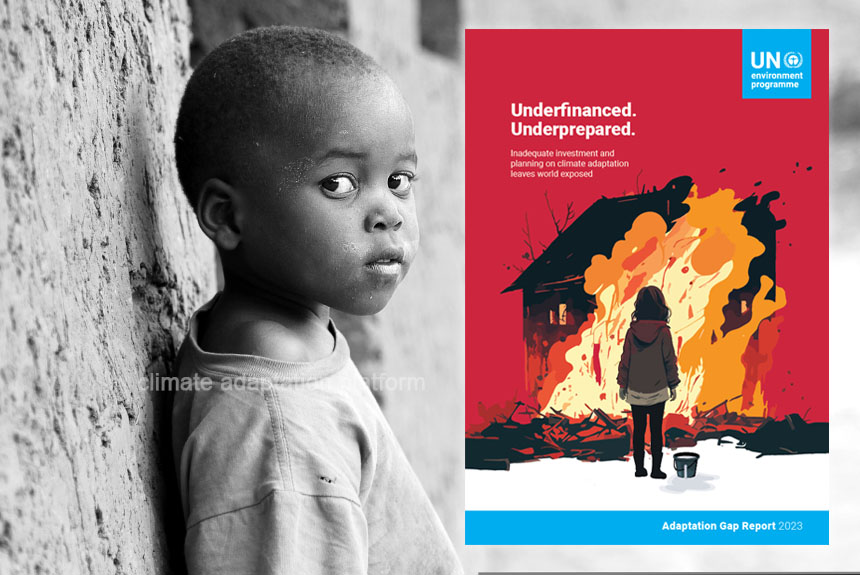The UNEP Adaptation Gap Report 2023, “Underfinanced. Underprepared. Inadequate investment and planning on climate adaptation leaves world exposed”, looks at the progress in planning, financing, and implementing adaptation actions and reveals the enormous adaptation finance gap for developmental countries. It stands between US$194 and 366 billion annually – or 10 to 18 times bigger than current funding.
UNEP Executive Director Inger Anderson writes, “In 2023, climate change yet again grew more disruptive and deadly. Temperature records toppled, globally and regionally. Storms, floods, heatwaves and wildfires caused devastation. These intensifying impacts tell us two things: the world must urgently cut greenhouse gas emissions and it must increase adaptation efforts to protect vulnerable populations. Neither is happening.”
The report finds progress on climate adaptation is slowing down in all three areas – finance, planning and implementation when it should speed up to catch up with the growing impacts and risks of climate change. The massive climate adaptation gap will mean that many people, particularly from developing countries, will have to face the full implications and consequences of climate change without enough protection and the least able to cope.
The report published on November 2023 identifies seven ways to bridge the adaptation gap:
- International public adaptation finance, which remains a dominant measure;
- Domestic expenditure on adaptation;
- Private-sector finance for climate adaptation;
- Remittances by migrants to their home countries, which often contribute significantly to GDP;
- Increasing finance tailored to small and medium-sized enterprises since they comprise the bulk of the private sector in many developing countries;
- Reform of the global financial architecture, for instance, to boost developing countries’ resilience against future climate shocks, including through changes and managing their debt burden;
- Implementation of article 2.1 of the Paris Agreement on making finance flows consistent with a pathway towards low-carbon and climate-resilient development.
Even if the world stops global emissions today, climate change impacts will continue, and it will take decades to stabilise the climate again. The report says that investing in climate adaptation and mitigation will minimise the costs of loss and damage in the future.
The report consists of five chapters which discuss the following topics:
Chapter 1: The political and scientific content. The Adaptation Gap Report (AGR) series assesses recent literature and tracks primary sources of information to provide annual policy-relevant updates on global progress in climate adaptation, building on an increasingly clear scientific evidence base and diversifying policy landscape.
Chapter 2: Global progress on adaptation planning. At present, 85 per cent of countries have at least one national-level adaptation planning instrument in place. As the world moves towards complete coverage by national adaptation planning instruments, a rapid shift towards implementation and continued, iterative planning is vital – which must be supported by, among other things, greater availability of and access to finance.
Chapter 3: Global progress on adaptation implementation. In 2022, new adaptation projects at a combined value of US$559 million in grants from the Adaptation Fund (AF), the Green Climate Fund (GCF) and the Global Environment Facility (the GEF via its Least Developed Countries Fund [LDCF] and Special Climate Change Fund [SCCF]) started implementation.
This is 10 per cent higher than the average amount implemented over the preceding five years (2017–2021). The average number of new climate adaptation projects that started under these three multilateral funds plateaued at just under 40 projects per year during 2013–2022. Due to GCF, the average size of grant-funded adaptation projects has increased. Since 2017, an average of 15 per cent of new adaptation projects have received grant funding of over US$25 million.
Chapter 4: Adaptation finance gap. This chapter provides a comprehensive assessment of the literature. It has commissioned new studies to provide updated estimates of the cost of adaptation, current adaptation finance flows, and, thus, the adaptation finance gap for developing countries. This new assessment’s adaptation costs are estimated to be in a plausible central range of US$215–387 billion/year for developing countries this decade. This is a significant increase from the previous Adaptation Gap Report estimate.
Chapter 5: Loss and damage. A third key pillar of climate policy emerged in the United Nations Framework Convention on Climate Change (UNFCCC) alongside climate adaptation and mitigation to address the ever-increasing climate impacts in developing countries particularly vulnerable to the adverse effects of climate change.
Losses and damages arise when efforts to avoid or minimise climate impacts through climate adaptation and mitigation fail. Given the slow progress in reducing greenhouse gas (GHG) emissions and adapting to climate risks, some losses and damages are occurring, and further losses and damage are unavoidable.
Source:
United Nations Environment Programme (2023). Adaptation Gap Report 2023: Underfinanced.
Underprepared. Inadequate investment and planning on climate adaptation leaves world exposed. Nairobi. https://doi.org/10.59117/20.500.11822/43796



Leave a Reply